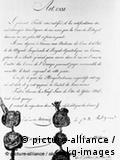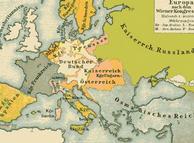History | 16.11.2009
The Congress of Vienna - September 18, 1814
More than 200 authorized officials from European states converged in the Austrian city of Vienna to discuss a new order for the continent in a congress held from September 1814 until June 1815. For the most part, the "new order" consisted of a re-establishment of the old European monarchies. During the time of French rule over the continent, they had not only lost territory, but also influence. The restoration of this old Europe was simultaneously a rejection of the revolutionary goals of the French Revolution, as well as the nationalist movements gaining pace in many European countries.
The dancing congress
As the host city, Vienna put its best face forward, organizing an array of balls and social events that changed on a daily basis. The brisk progression of evening dances inspired Belgian diplomat Charles Joseph, de Ligne to say in a letter to French Foreign Minister Charles Maurice de Talleyrand that: "The congress of Vienna does not run, it dances." He added that "nothing is getting through, except for the sweat of these dancing men."
 Bildunterschrift: Großansicht des Bildes mit der Bildunterschrift: Vienna Congress ratification document
Bildunterschrift: Großansicht des Bildes mit der Bildunterschrift: Vienna Congress ratification document
But the men were not just there to dance. Rather, decisions were made which would prove to be an instrumental part of European history.
Restoration
In Europe, equality between the five largest powers, France, England, Prussia, Russia and Austria (the "Pentarchy") was restored. Although France had to give back the territories claimed during the Napoleonic wars, it emerged as a victor of the Congress of Vienna. France, with its hegemonic pursuits under the leadership of Napoleon, may have been the source of Europe's undoing, but now, a French delegation was sitting at the negotiating table in Vienna!
While France had to surrender territory, the other large powers were granted land, as were several smaller states (Sweden, the Netherlands). Poland, which had existed merely as the small duchy of Warsaw since the "Polish partitions" in 1772, 1793 and 1795, was re-established on the European map as "Congress Poland." Additionally, Switzerland's neutrality was internationally recognized.
The German Federation
In the middle of the continent, the "Confederation of the Rhine" established by Napoleon was dissolved, replaced by the "German Federation." It consisted of 35 states or principalities, and four city states. Austria and Prussia were also made members, even though parts of their territory lay outside the area of the German Federation. Both had been part of the Holy Roman Empire of the German Nation until its dissolution, and so laid claim to rights in Germany. The highest council was the Bundestag (parliament), which met in Frankfurt under the chairmanship of Austria.
 Bildunterschrift: Europe after the Congress of Vienna
Bildunterschrift: Europe after the Congress of Vienna
The creation of the German Federation was one of the most important decisions to come out of the congress. But the birth defects are impossible to ignore. On the one hand, the European powers wanted to ensure that Germany's individual states remained independent; on the other, they wanted to link them to each other in a federation and, through the participation of Austria and Prussia, link them to their geostrategic interests. Representatives of the German states were not present at the negotiations, meaning that their interests were barely taken into consideration.
With the Congress of Vienna, the "German question" was once again subjected to a European proviso, because every change to the status quo in Europe was dependent on the agreement of the so-called "Holy Alliance": the Prussians, the Austrians and the Russians. These three monarchies made sure that the European prescription for peace developed in Vienna was respected. It was the second attempt by the European states after 1648 (Peace of Westphalia) to view the continent as a whole, and to create a common framework for peace. This "Conference for Security and Cooperation in Europe" failed equally, however, because the nationalist and, later, the democratic movements were determined not to be subjected to any absolutist or Christian-patriarchal form of government.
Author: Matthias von Hellfeld (dc)
Editor: Andreas Illmer

Comments